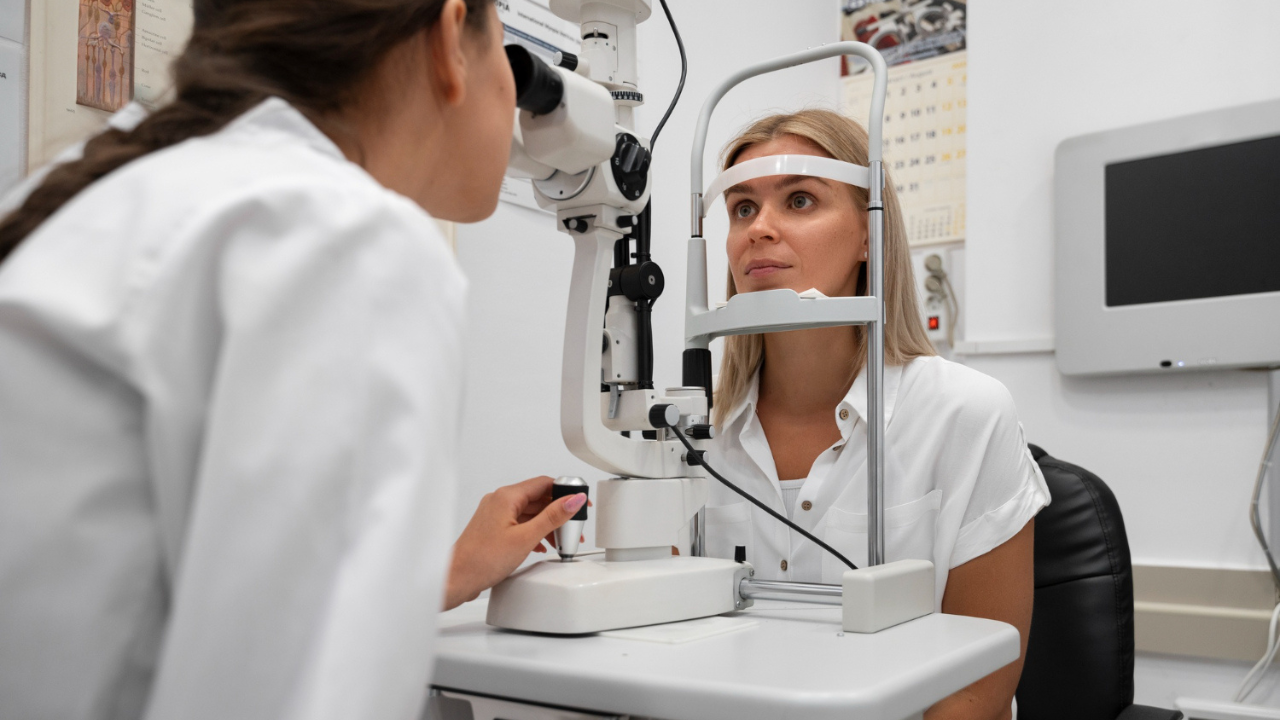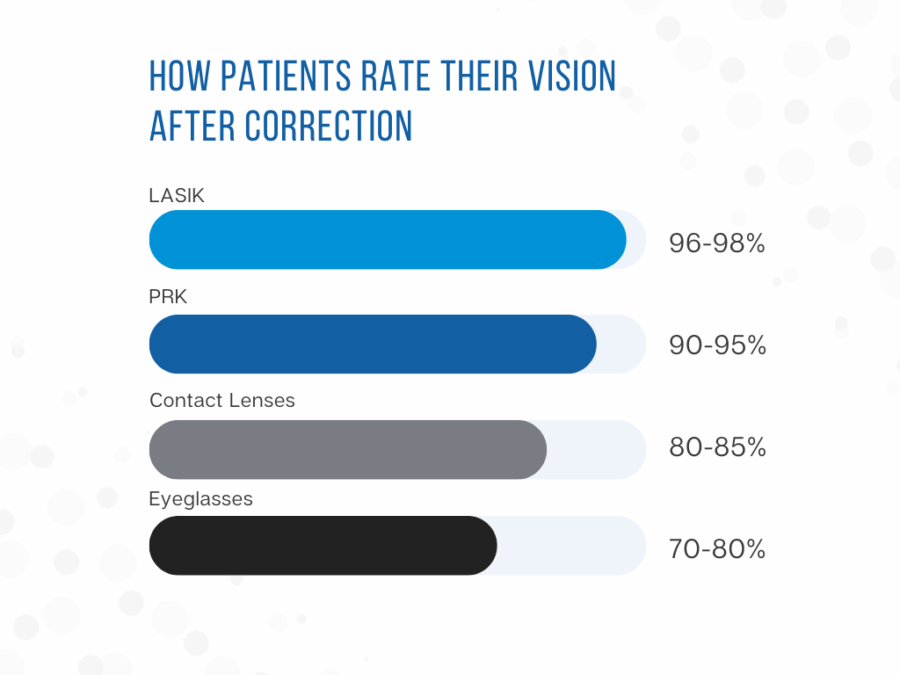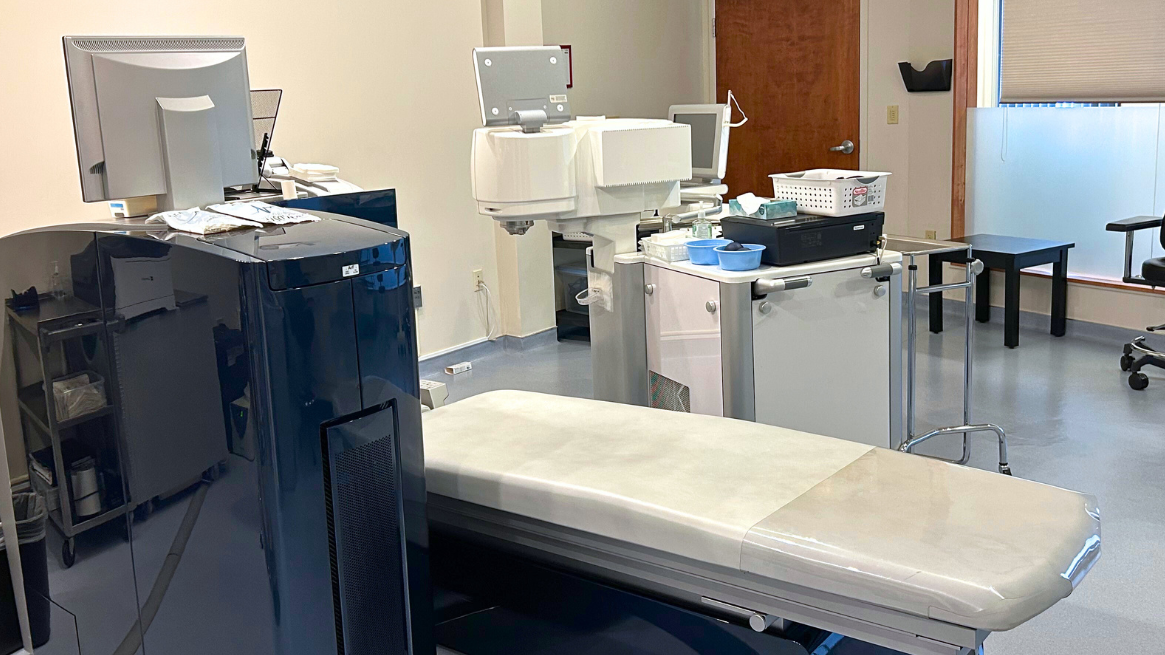
Is LASIK Surgery Safe?
Short Answer: Yes. LASIK is considered one of the safest elective procedures in the world. With over 20 million successful treatments performed in the United States alone and a global satisfaction rate above 96%, LASIK has transformed how people see — and how safe elective surgery can be.
LASIK Safety at a Glance
- ✅ FDA-approved lasers for precision and safety
- ✅ Over 90% of patients achieve 20/20 vision or better
- ✅ Less than 1% serious complication rate (one of the lowest of all elective surgeries)
- ✅ 96–98% patient satisfaction across decades of studies
- ✅ Safer long-term than years of contact lens wear in many cases
How Safe Is LASIK Eye Surgery?
LASIK (Laser-Assisted In Situ Keratomileusis) reshapes the cornea using computer-guided laser technology. The goal is simple: improve how light focuses on the retina, reducing or eliminating the need for glasses and contacts.
Safety comes from three factors:
- Technology: Today’s femtosecond and excimer lasers are guided by corneal-mapping software, making treatment safer and more precise than early LASIK methods.
- Screening: Surgeons carefully evaluate corneal thickness, prescription stability, and eye health to ensure only the right candidates move forward.
- Experience: With more than two decades of surgical refinements, LASIK outcomes are more predictable than ever.
Quick Fact: A large FDA clinical trial found that more than 95% of participants were satisfied with their vision after LASIK, with complication rates under 1%.
How Safe Is LASIK Compared to Other Options?
When people ask “Is LASIK safe?” they often mean: safer than glasses? Safer than contact lenses? Safer than other eye surgeries?
Here’s a breakdown:
| Vision Correction Method | How Safe Is It? | Common Drawbacks | Patient Satisfaction |
|---|---|---|---|
| LASIK | Very high safety, less than 1% risk of complications | No surgical risks, but ongoing cost, inconvenience, and lens damage possible | 96–98% |
| Contact Lenses | Good daily safety, but long-term risk of infection and corneal damage | Up to 1 in 100 annual risk of serious infection with extended wear; higher with poor hygiene | 80–85% |
| Eyeglasses | Very safe, no medical risk | Less than 1% complication rate; stable long-term outcomes for most patients | 70–80% |
| PRK | High safety, slightly longer healing than LASIK | Equally safe but longer recovery compared to LASIK | 90–95% |
👉 Studies suggest that for some patients, long-term contact lens use carries more risk of vision-threatening infections than LASIK surgery itself.

LASIK Success Rates: The Numbers Behind the Safety
When evaluating LASIK safety, success rates matter.
- 99% of LASIK patients achieve 20/40 vision or better (the legal requirement for driving without corrective lenses in the U.S.)
- 90% of patients achieve 20/20 vision or better
- Fewer than 1% experience significant vision loss (two or more lines on the eye chart)
- 96–98% report satisfaction with their results (ASCRS, peer-reviewed studies)
Global Perspective: Since its introduction in 1989, over 40 million procedures have been performed worldwide. The consistency of positive outcomes makes LASIK one of the most trusted elective procedures available today.
Transform Your Vision
Is LASIK FDA Approved?
Yes. LASIK is FDA-approved for safety and effectiveness. Approval requires:
- Rigorous clinical trials proving vision correction success rates
- Manufacturing inspections to ensure device safety
- Long-term monitoring of surgical outcomes
At LASIK.com, we exclusively use FDA-approved lasers. Our network of surgeons are not only board-certified but also among the most experienced LASIK providers in the country.

What Are the Side Effects of LASIK?
Like any medical procedure, LASIK can cause temporary side effects. Most improve within days or weeks:
- Mild discomfort (itching, burning, scratchy feeling)
- Blurry or hazy vision during initial healing
- Glare or halos around lights (especially at night)
- Dry eyes — common but treatable with lubricating drops
- Light sensitivity for a few weeks post-op
👉 The majority of patients find these symptoms resolve naturally as the eyes heal.
What Are the Risks of LASIK?
Although rare, LASIK carries risks that patients should be aware of:
- Overcorrection or undercorrection (vision not fully corrected — often adjustable with an enhancement)
- Regression (a gradual return of refractive error, more likely with high prescriptions)
- Night vision disturbances such as halos or glare (less common with modern wavefront-guided lasers)
- Flap complications (extremely rare thanks to advanced femtosecond lasers)
- Infection or inflammation (rare and typically treatable with medication)
Risk in Perspective:
In one study, the rate of sight-threatening complications is less than 0.98% — making LASIK one of the safest elective procedures in medicine.
Is LASIK Safe for Astigmatism?
Yes. LASIK is FDA-approved to treat astigmatism and is highly successful. Modern wavefront and topography-guided lasers customize treatment to the unique curvature of each cornea.
Studies show patients with astigmatism achieve the same high satisfaction rates as those treated for nearsightedness and farsightedness.
Is PRK Safer Than LASIK?
Both LASIK and PRK are safe, effective, and FDA-approved. The main differences:
- LASIK: Faster recovery, less discomfort, but involves creating a corneal flap
- PRK: No flap, often chosen for patients with thinner corneas, but requires longer healing time
Safety outcomes are similar for both. The choice usually depends on individual eye anatomy.
Long-Term LASIK Safety: What the Research Shows
LASIK isn’t just safe immediately — it’s safe for the long haul.
- A 10-year follow-up study published in Ophthalmology found that over 90% of patients maintained 20/25 vision or better a decade after surgery.
- Enhancements are rare, but some patients may choose a “touch-up” years later if vision shifts due to natural aging or presbyopia.
- LASIK does not prevent age-related changes like cataracts or presbyopia, but it does provide stable distance vision for decades.
Who Should Avoid LASIK?
LASIK is safe for most healthy adults, but certain conditions increase risk:
- Severe dry eye
- Thin or irregular corneas
- High refractive errors
- Autoimmune disorders (like rheumatoid arthritis)
- Unstable prescriptions
- Pregnancy or breastfeeding (due to hormonal vision fluctuations)
For these patients, PRK or other alternatives may be recommended.

Who Can You Trust for Safe LASIK?
LASIK safety depends on two factors: technology and surgeon expertise.
At LASIK.com, we are committed to both:
- Only FDA-approved lasers are used across our centers
- Our surgeons are board-certified ophthalmologists with years of LASIK experience
- We provide comprehensive evaluations to ensure candidacy
- We support you with personalized care before, during, and after surgery
Frequently Asked Questions
Is LASIK safe?
Yes. LASIK has a complication rate under 1% and success rates above 95%.
How safe is LASIK compared to contacts?
Contact lenses carry an annual infection risk of about 1 in 100. LASIK’s risk of serious complication is less than 1 in 500, making it statistically safer long-term for many patients.
Is LASIK safe for astigmatism?
Yes. Modern lasers safely and effectively correct astigmatism.
Is LASIK safe long term?
Yes. Most patients enjoy decades of stable vision, with satisfaction rates remaining above 90% in long-term studies.
Is PRK safer than LASIK?
Both are safe. PRK is often chosen for patients with thin corneas, while LASIK offers faster recovery.
Is LASIK safe Reddit users say?
While personal experiences on Reddit vary, large-scale medical studies consistently show LASIK is safe, effective, and delivers very high patient satisfaction.
The Bottom Line
LASIK has one of the strongest safety records in modern medicine. With FDA-approved technology, experienced surgeons, and careful patient screening, the risks are low and the outcomes life-changing.
If you’re asking “Is LASIK safe for me?” the best way to know is to schedule a free consultation at a LASIK.com center near you. You will be given a personalized evaluation and honest answers about your candidacy.
PROWL-1 provides new insights on LASIK outcomes. (2020, November 15). Ophthalmology Times. https://www.ophthalmologytimes.com/view/prowl-1-provides-new-insights-lasik-outcomes
Zhu, A., Burton, C., Tseng, C. C., Ling, J., Mahajan, J., & Zhu, D. (2025). Patient-Reported LASIK Outcomes on RealSelf: a Social Media Review Platform. Clinical Ophthalmology, Volume 19, 2029–2036. https://doi.org/10.2147/opth.s528272
Center for Devices and Radiological Health. (2021, June 17). LASIK Quality of Life Collaboration Project. U.S. Food And Drug Administration. https://www.fda.gov/medical-devices/lasik/lasik-quality-life-collaboration-project
Schallhorn, S. C., Venter, J. A., Teenan, D., Hannan, S. J., Hettinger, K. A., Pelouskova, M., & Schallhorn, J. M. (2016). Patient-reported outcomes 5 years after laser in situ keratomileusis. Journal of Cataract & Refractive Surgery, 42(6), 879–889. https://doi.org/10.1016/j.jcrs.2016.03.032
Joffe, S. N. (2021b). The 25th anniversary of laser vision correction in the United States. Clinical Ophthalmology, Volume 15, 1163–1172. https://doi.org/10.2147/opth.s299752
Chua, D., Htoon, H. M., Lim, L., Chan, C. M., Mehta, J. S., Tan, D. T. H., & Rosman, M. (2018). Eighteen-year prospective audit of LASIK outcomes for myopia in 53 731 eyes. British Journal of Ophthalmology, 103(9), 1228–1234. https://pubmed.ncbi.nlm.nih.gov/30355717/
Eydelman, M., Hilmantel, G., Tarver, M. E., Hofmeister, E. M., May, J., Hammel, K., Hays, R. D., & Ferris, F. (2016). Symptoms and Satisfaction of patients in the Patient-Reported Outcomes with Laser In Situ Keratomileusis (PROWL) Studies. JAMA Ophthalmology, 135(1), 13. https://doi.org/10.1001/jamaophthalmol.2016.4587